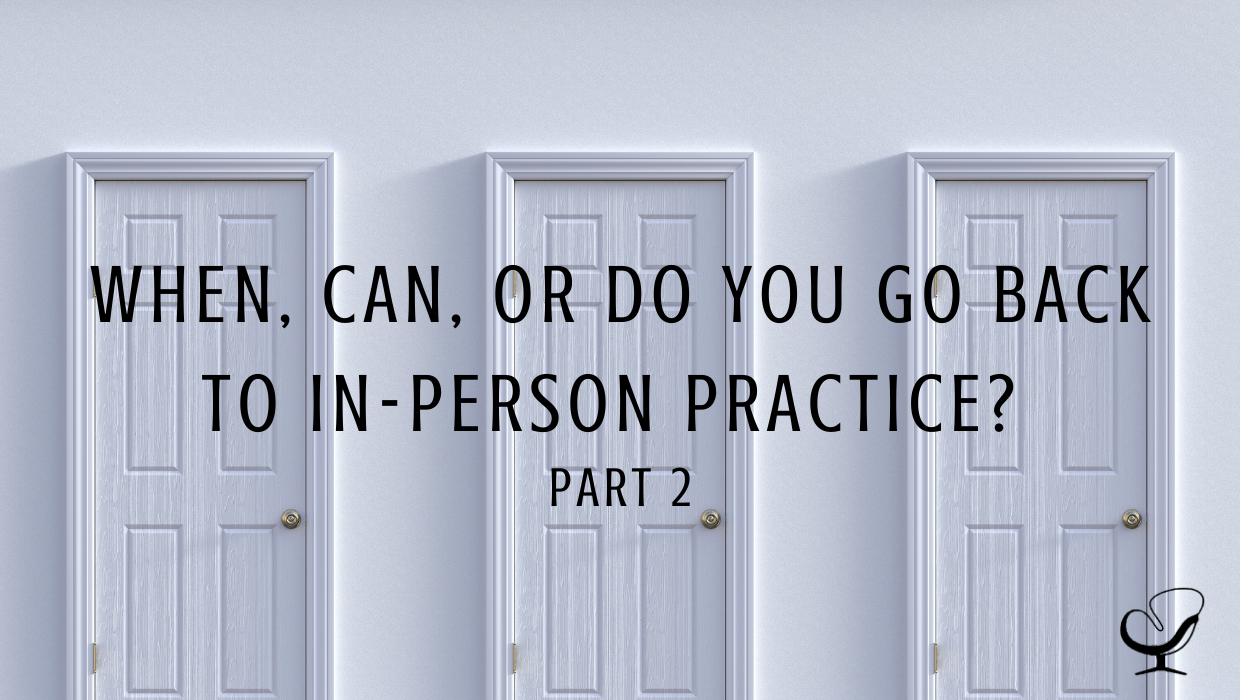In Part 1, I focused on considering the personal reasons you may decide to return to an in-person private practice when COVID still exists. Aside from each of our own personal decisions as to whether or not to do so, there are other, more practical things to consider when going back to in-person Practice:
Day-to-Day Changes to Consider When Going Back to In-Person Practice
The day-to-day, procedural changes you may need to consider about running a practice are simply unlike anything we, as practitioners, have ever had to think about before the pandemic.
For one, spacing is something to consider. I don’t know about you, but before the pandemic, I never even gave a thought as to how many feet there were in between the waiting area chairs. Or how many feet there was between myself and clients in my office. Now that I think about it, there really is no way I can return to the office I had before. It simply isn’t large enough for there to be 6 feet of space between me and any individual client. There certainly is no way I can see a couple or a small group.
Are You Putting Yourself, Your Family, and Clients at Risk When Going Back to In-Person Practice?
The health of yourself and all of your clients are also something to consider now. Does seeing clients in person put your own health at risk? Or, will your increased exposure to more people now also increase the health risk to those with whom you live? What about others in your office? Do you have office mates? A receptionist? Clients who may cross paths in-between sessions? The list can become overwhelming to consider.
Similarly, do you have any clients who are part of a population that is at higher risk for COVID-19? If you choose to go back to in-person sessions, what about those clients? Do they feel comfortable leaving home to come and see you face-to-face? What about if they prefer to continue seeing you virtually because of this? Will you still offer virtual sessions, or solely return to offering in-person sessions? So many things to consider, but I’m just putting it all out there!
Extra Time and Health & Safety Protocols to Include
Something else that I had not even thought about until a client recently asked me was simply how I would have to allot for extra time in between patients just to adhere to health and safety protocols. Never before did I have to think about wiping down door handles or anything clients had touched before the next client came into the office. But now, I realize that I would have to take some time in between each client to do so.
While adding in this extra time in between clients would allow the time to disinfect and sanitize, it would also reduce the risk that clients would be exposed to one another in between sessions. Before the pandemic, I would often schedule clients back to back, so there would be a high likelihood that they would pass one another in the hallway, bathroom or reception area.
And, while potentially reducing risk for COVID-19, this certainly will add a lot of extra work and time to my day. I don’t know about you, but this is something to really consider. I find my time in between clients precious. It is when I finish notes or have a quick minute to get a bite, check my phone or run to the bathroom. To lose that or know my day will be extended even longer, simply because I have to sanitize in between each and every client would be a definite reason to consider staying virtual for now.
Other Points to Consider When Going Back to In-Person Practice
I also realize that I would have to know and adhere to State and local regulations before I could even think about returning to my office to see client in person. Is this even allowed? If so, what are my (and your) requirements for such things as requiring masks, using hand sanitizer, or taking temperature? What if a client refuses to comply with any of these requirements?
Even more, general office policies and procedures would have to change. Things like:
- Would you require clients to do a COVID screening before they came into the office?
- What would you decide to do if they were at-risk?
- What if a client who came in later informed you that they tested positive for COVID-19?
- How would you notify other clients who had come in after this client? How would you then proceed with seeing clients?
If You’d Like More Info on Compliance Issues for Practices, I’d highly recommend checking out this article, “Important but Overlooked Compliance Issues for Practices.”
Communicating Changes to Clients
All of these new changes to your office policies and procedures will also need to be communicated to your clients. How will you go about doing this? Will you create new office policies and procedures forms and have each client sign them? Or will you email them prior to reopening clearly communicating to help set the right expectations upfront?
At the very least, I suggest emailing each client informing them of the following:
- Reopening date
- Office Hours
- Any new policies and procedures (i.e. new cancellation policies; mask requirement, etc.)
- Measures you’ve taken to ensure health and safety
- Client physical health requirements (screening questions on page 4 of this document provided by AMA)
The American Psychological Association (APA) has a sample consent form that therapists can have clients read and sign prior to returning to in-person sessions.
The return to running a practice in person – while we are still in the midst of the pandemic – is sure to bring about some challenges and many changes that none of us have ever had to face. The decision to stay virtual or return to in-person has many personal, as well as practical considerations that I have discussed in both part 1 and 2.
This has been a challenging year for all of us. The way we practice has changed. I hope you all stay safe and healthy in whatever way you choose to continue running your practice.
About Cristina Castagnini, Ph.D., CEDS
 Cristina Castagnini, Ph.D., CEDS, is a licensed psychologist and is recognized as a Certified Eating Disorder Specialist by the International Association of Eating Disorder Professionals (IAEDP). She graduated with honors, earning her bachelor’s degree in psychology from The University of California, Santa Cruz, her Master’s Degree in clinical psychology (with an emphasis in Marriage and Family Therapy) from Pepperdine University, and her doctoral degree in counseling psychology at the University of Southern California. Find out more here. Listen to Cristina’s Behind the Bite Podcast Series here.
Cristina Castagnini, Ph.D., CEDS, is a licensed psychologist and is recognized as a Certified Eating Disorder Specialist by the International Association of Eating Disorder Professionals (IAEDP). She graduated with honors, earning her bachelor’s degree in psychology from The University of California, Santa Cruz, her Master’s Degree in clinical psychology (with an emphasis in Marriage and Family Therapy) from Pepperdine University, and her doctoral degree in counseling psychology at the University of Southern California. Find out more here. Listen to Cristina’s Behind the Bite Podcast Series here.

